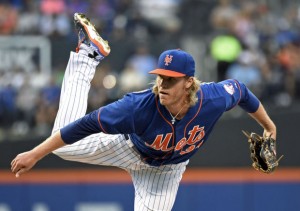This year’s installment of si.com’s Tom Verducci‘s “Year After Effect” (which he’s trying to use as the title instead of the eponymous “Verducci Effect” that i’ve grown used to using) was published this week and he’s definitely gone conservative in his ominous predictions. In year’s past he’s used a 20% year over year increase and listed many candidates … now he’s down to just a handful a year with a more conservative 30% workload increase. For 2016, he’s identified 5 candidates for his watch list.
Here’s some posts on this same topic from year’s past: 2013 year after effect and 2014 year after effect (I somehow forgot to do this post last year). In the 2013 post, there’s some counter-arguments to whether or not his observation actually exists, with research on all pitchers who qualified for the thresholds he laid out at the time. I won’t go into the same arguments made there; what I will do is point out the actual results of his predictions (Link to my working XLS showing all the core numbers referenced here):
- 2013: 11 candidates mentioned, 5/11 regressed or got injured the following year (but, it should be noted, that another 3 of the candidates he mentioned have completely fallen off a cliff in subsequent years). 8/11 candidates showed regression: 72% prediction rate.
- 2014: 10 candidates mentioned; 8/10 regressed and more shockingly 6/10 had arm injuries. 80% prediction rate.
- 2015: 14 candidates mentioned (only 5 “main” ones were on his true watch list): 11 of those 14 regressed or got hurt. One of the 14, Marcus Stroman missed the whole season with a knee injury but counts as a non-regression candidate, so frankly its 11 of 13 guys who actually pitched all year. 84% prediction success rate.
So for me, his analysis is less about running pure numbers to find candidates and more about giving context to the pitchers he selects. Mostly they’re starters (not relievers), mostly they’re young and mostly they’re guys who had to pitch high leverage innings on top of vastly increased workloads.
So who’s listed this year? Basically five young pitchers who had massive innings spikes and four of which pitched into the post-season.
| 2016 Candidate Name/Team | Age as of Jan 2016 | 2015 IP | 2015 IP delta | 2015 ERA | 2015 FIP | 2015 xFIP | 2015 SIERA |
| Lance McCullers, Houston | 21 | 164 | 59 1/3 | 3.22 | 3.26 | 3.5 | 3.57 |
| Noah Snydergaard, NY Mets | 22 | 198 2/3 | 65 2/3 | 3.24 | 3.25 | 2.91 | 2.95 |
| Luis Severino, NY Yankees | 21 | 161 2/3 | 48 2/3 | 2.89 | 4.37 | 3.72 | 3.84 |
| Carlos Martinez, St. Louis | 23 | 179 2/3 | 52 2/3 | 3.01 | 3.21 | 3.28 | 3.44 |
| Tyler Duffey, Minnesota | 24 | 196 | 46 2/3 | 3.1 | 3.24 | 3.64 | 3.83 |
I’d be most worried about McCullers (who is super young and showed some fatigue down the stretch) and Severino (also very young but who also had significantly softer advanced stats than his ERA showed) in terms of regression in 2016. Snydergaard seems big enough to perhaps withstand the added workload. Martinez was a surprise reason why St. Louis’ rotation was so good last year; can he make the jump too?
Curious why he didn’t put in Matt Harvey, especially after all the BS about innings limits. He had 178 IP in 2013, Zero in 2014 and then 189 1/3 regular season and another 26 2/3rds in the 2015 post-season. That’s 215 innings the year after surgery. I’d be pretty worried if I was Mets fans … but hey, flags fly forever!
